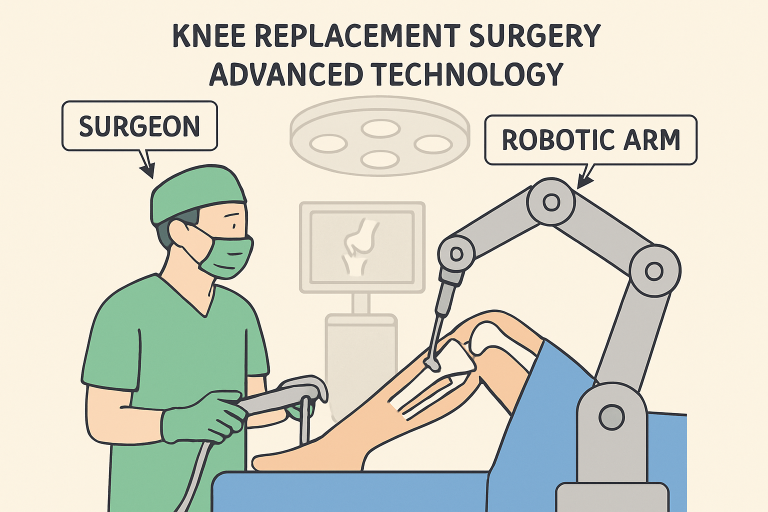Key Takeaways
- Robotic-assisted surgery greatly improves precision in joint replacement procedures.
- Patients frequently benefit from shorter recovery times and less postoperative pain.
- Ongoing research seeks to advance and refine robotic surgical methods further.
Robotic-assisted joint replacement surgery is rapidly redefining the standards of orthopedic care by offering unparalleled accuracy in the surgical process. As more surgeons and hospitals adopt robotic platforms, patients are reaping the rewards of cutting-edge technology that streamlines operations and enhances outcomes. In particular, the advanced Mako robotic knee replacement for precision surgery has emerged as a leading solution, providing greater consistency and optimal implant placement. The rapid growth of robotic technology continues to inspire both confidence and curiosity among medical professionals and patients alike.
The integration of robotics in joint replacement procedures not only improves the technical aspects of operations but also positively impacts the entire patient experience. From preoperative planning to reduced incision sizes and speedier recoveries, patients can look forward to better results and less postoperative discomfort. As this technology continues to evolve, it’s poised to become a foundational standard in joint replacement, setting new benchmarks for quality and care in orthopedic surgery.
The Evolution of Robotic-Assisted Surgery
Over the past decade, the field of orthopedic surgery has undergone a significant transformation with the adoption of robotic technology. Surgeons now have access to advanced planning tools and real-time intraoperative feedback, both of which are crucial for achieving superior surgical outcomes. Specifically in knee and hip replacements, the adoption of robotics enables surgeons to customize procedures to each patient’s unique anatomy, addressing individual needs with a level of detail traditional methods struggle to match.
Robotic systems, such as those developed for the Mako platform, help surgeons by creating a precise three-dimensional model of the patient’s joint. This enables meticulous mapping and optimal implant alignment, thereby reducing the risk of misplacement and increasing the likelihood of long-term joint functionality. As a result, patients experience greater satisfaction and fewer post-surgical complications compared to conventional orthopedic surgery.

Benefits of Robotic-Assisted Joint Replacement
There are several compelling reasons why patients and surgeons increasingly opt for robotic-assisted joint replacements:
- Enhanced Precision: The integration of real-time feedback and robotic guidance enables precise bone preparation, alignment, and implant placement. This precision is linked to better joint stability and longevity.
- Faster Recovery: By minimizing soft tissue trauma and using smaller, more targeted incisions, robotic surgery contributes to less postoperative pain and swelling, facilitating a quicker return to normal daily activities.
- Greater Consistency: Robotic technology standardizes the operative process, reducing the variability seen with manual techniques and leading to more predictable and favorable surgical outcomes.
Resources such as DMC’s overview of robot-assisted joint replacement highlight how these technological advancements have led to greater patient satisfaction and improved long-term results.
Recent Innovations in Robotic Surgery
Recent years have seen several remarkable advancements in robotic-assisted surgery. Leading institutions, including Mayo Clinic, are at the forefront of research into integrating robotics with data science and personalized care. By combining vast collections of patient data with machine learning, healthcare providers can more accurately predict which patients will benefit most from specific robotic procedures, thereby further individualizing care and optimizing outcomes.
Technological advancements in imaging, navigation, and robotics integration have also enabled systems capable of handling increasingly complex cases. With improved sensors and more intelligent algorithms, these robotic platforms would allow surgeons to achieve precision that was previously unattainable with conventional methods alone.
Challenges and Considerations
While the promise of robotic-assisted surgery is considerable, adoption comes with a few notable challenges:
- High Costs: Robotic surgery systems require a significant investment, which can limit access, particularly in smaller or underfunded healthcare institutions.
- Learning Curve: Surgeons must undergo extensive training to master new systems, with a transitional period required to achieve the same proficiency as with traditional techniques.
- Technical Reliability: As with any advanced technology, malfunctions or system errors are possible, necessitating rigorous maintenance, updates, and backup plans during surgery.
Healthcare providers must balance the promise of improved surgical results with the realities of cost, training, and the potential for technical complications. Nevertheless, ongoing advancements in user interface design and artificial intelligence are steadily addressing these challenges, lowering barriers to widespread adoption.
The Future of Robotic-Assisted Joint Replacement
The trajectory of robotic-assisted joint replacement surgery continues to point toward a future marked by even greater precision, accessibility, and personalization. Medical researchers are working to integrate artificial intelligence to assist surgeons during planning and real-time decision-making, as well as to design cost-effective solutions that expand access to robotic platforms globally. As technology matures, collaboration among tech companies, research institutions, and clinicians promises even more powerful enhancements to both procedures and patient experiences.
Conclusion
Robotic-assisted joint replacement represents a transformative advancement in orthopedic surgery, delivering unparalleled precision, enhanced patient outcomes, and shorter recovery times. As innovations continue to shape the field, patients and providers can expect procedures that are safer, more effective, and increasingly tailored to individual needs. The future of joint replacement is being written today in operating rooms equipped with the latest robotic technology, promising brighter prospects for orthopedic care worldwide.
